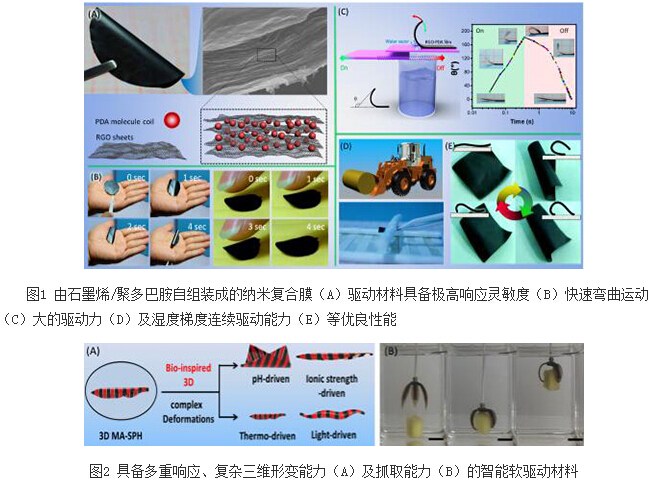Intelligent soft drive material refers to a polymer material that can convert various energy (gradient potential energy of light energy, heat energy, chemical energy, and gas) into mechanical energy and then undergo reversible deformation under a certain external stimulus. In recent years, soft-driven materials have caused great research interest in many high-tech fields such as robots, sensors, and in-vivo surgical equipment. However, it is usually limited to the composition and structure of the constituent materials. These drive materials have serious shortcomings in driving efficiency and speed, mechanical stability, response sensitivity, deformation controllability, and complexity, and restrict the use of soft-driven materials. Further application.
The team of smart polymer materials led by researcher Chen Tao of the Institute of Materials Technology and Engineering of the Chinese Academy of Sciences had previously developed a series of shape memory hydrogel soft drive materials and achieved a phased progress (Chem. Commun. 2014, 50, 12277; Macromol Rapid Commun. 2015, 36, 533; Polym. Chem. 2016, 7, 5343; Chem. Sci. 2016, 7, 6715; Chem. Commun. 2016, 52, 13292), but the drive capacity and response sensitivity of these materials Still insufficient; based on the research foundation of the team in carbon-based materials and polymer composites (Chem. Commun., 2013, 49, 11167; Chem. Commun., 2014, 50, 7103; J. Mater. Chem. A Mater. Interfaces, 2014, 6, 16204; J. Mater. Chem. A, 2015, 3, 4124; Adv. Funct. Mater., 2015, 25, 2428; J. Mater Chem. A, 2016, 4, 10810; Chem. Mater., 2016, 28, 7125). The team recently prepared by synergizing the sensitivity of polydopamine to water vapor and the unique gas barrier properties of carbon-based materials such as graphene. Nano-composite smart soft-driven materials based on stimuli-responsive polymers and graphene. The researchers assembled a dispersion of large-size reduced graphene oxide/polydopamine (RGO-PDA) nanocomposite sheets prepared in-situ polymerization into a macro-scale layered structure nanocomposite film by adopting a vacuum filtration self-assembly method. (Figure 1-A). Under the driving of water vapor gradient, the film has extremely high response sensitivity (Fig. 1-B), rapid movement capability (1000°/s) (Fig. 1-C), strong driving force (it can carry 42 times its own weight) ( Figure 1-D) and continuous spontaneous movement (Figure 1-E) and other excellent performance. This material breaks through the limitation of driving with only a two-layer structure material, and can realize the formation of a double-layered structure in-situ in the external stimulating process, and then driving, which provides a new type of fast, highly sensitive driving material. A new idea (Adv. Mater. Interfaces, 2016, 3, 1600169).
If practical applications of soft drive materials are to be realized, there is an urgent need to develop new preparation methods to obtain various complicated deformations, especially three-dimensional (3D) complex deformations. Recently, the team's researchers used a UV in-situ reduction method to reduce the localized graphene oxide in the graphene oxide-poly(N-isopropylacrylamide) (GO-PNIPAM) composite hydrogel to a high degree. Controlled access to a specific anisotropic structure. Using this as a template, a second network of other stimulus responses can also be introduced in the unreduced region of the hydrogel, further achieving 3D complex deformation of multiple responses (heat, light, ionic strength, and pH response) (FIG. 2, Adv. Funct). Mater., 2016, DOI: 10.1002/adfm.201603448). Using this method, the researchers designed a bionic drive with complex intelligent deformation that can accurately capture targets in a specific area under multiple stimulus responses. This provides new ideas for the design and development of intelligent soft drive devices, especially for remotely controllable and multiple-response 3D complex drives.
This research has been supported by the National "Years of Thousand Talents Program", the "Top Young Scientist" of the Frontier Science and Education Bureau of the Chinese Academy of Sciences (QYZDB-SSW-SLH036), the National Natural Science Foundation of China (21304105, 51573203) and the Zhejiang Provincial Outstanding Youth Fund (LR14B040001). Funded with the Key Laboratory of Applied Research of Graphene in Zhejiang Province.

Household Electric Product,Home Appliances,Electrical Appliances,Household Appliances
ChangChun E-vida Technology Co.,ltd , https://www.evidatech.com